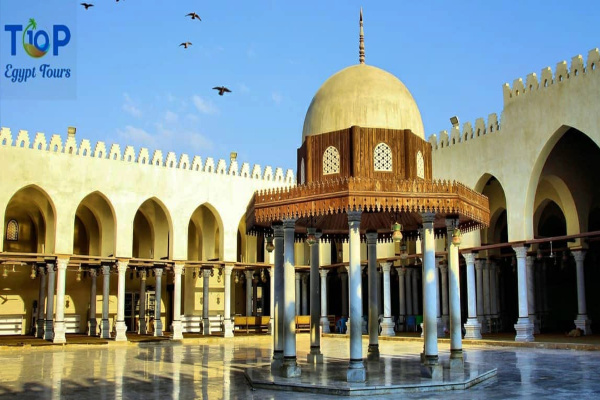Amr Ibn Al-Aas Mosque, located in Cairo, Egypt, holds significant historical and cultural importance as the first mosque built in Africa. This article explores the historical context, architectural features, and cultural significance of the Mosque of Amr Ibn Al-Aas, highlighting its role in the early spread of Islam and its enduring legacy in the Islamic world.
In this article, we will uncover for you the Amr Ibn Al-Aas Mosque with Top Ten Egypt.
Amr Ibn Al-Aas Mosque: A Symbol of Islamic Expansion
It stands as a symbol of the early expansion of Islam. This section delves into the architectural layout and features of the mosque, highlighting its simplicity, historical significance, and spiritual sanctity. We will discuss the atmosphere and aura that surrounds the mosque, as well as the sense of reverence felt by visitors.
Historical Context: The Birth of Islamic Presence in Africa
It has a profound historical background, marking the birth of Islamic presence in Africa. This section provides historical context, exploring the establishment of the mosque by Amr Ibn Al-Aas, a companion of the Prophet Muhammad, during the Muslim conquest of Egypt. We will discuss the mosque’s role as a center for religious and political activities during that time.
Architectural Features: Simplicity and Spiritual Elegance
It is characterized by its simplicity and spiritual elegance. This section highlights the architectural features of the mosque, including its courtyard, prayer hall, and minaret. We will explore the use of local materials, the incorporation of traditional Islamic architectural elements, and the mosque’s harmonious integration with the surrounding environment.
Cultural Significance: Preserving Islamic Heritage
Jami’ Amr Ibn al-Aas holds great cultural significance, representing the early spread and preservation of Islamic heritage. This section examines its cultural importance, discussing how the mosque became a center for religious teachings, Islamic scholarship, and the dissemination of Islamic knowledge. We will also explore its role in fostering community cohesion and religious practices.
Historical Events: Witness to Centuries of Change
It has stood witness to centuries of historical events and transformations. This section highlights some notable historical events that took place within and around the mosque, including political changes, architectural modifications, and the mosque’s enduring resilience despite challenges and conflicts.
Restoration and Preservation: Safeguarding a Historical Landmark
Preserving the historical and architectural integrity of the Jami’ Amr Ibn al-Aas is of utmost importance. This section explores the efforts undertaken for the restoration and preservation of the mosque over the years. We will discuss the challenges faced in maintaining the mosque’s original structure while ensuring its accessibility for worshippers and visitors.
Visitor Experience: Embracing History and Spirituality
Visiting the Mosque of Amr Ibn Al-Aas offers a unique and spiritually enriching experience for visitors, we offer a Tour to Islamic Cairo to Experience the magic of Cairo like never before and create unforgettable memories.
Conclusion:
It stands as a testament to the early spread of Islam and the enduring legacy of Islamic architecture. Through its historical context, architectural features, and cultural significance, the mosque represents a pivotal moment in African and Islamic history. By exploring the Mosque of Amr Ibn Al-Aas, visitors can immerse themselves in the rich historical and spiritual heritage of the mosque, deepen their understanding of early Islamic conquests, and appreciate the profound influence of this iconic landmark in shaping the religious and cultural landscape of Africa.



Comment (0)